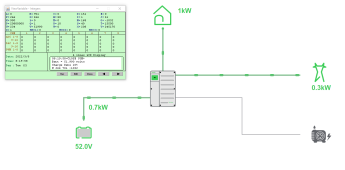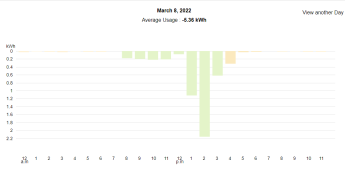Just a fun update this morning. Here is my SCE usage from yesterday.

The power used from 5 am to 7 am is on the cheapest rate, but it still should not have happened. My son let 250 watts of LED and florescent lighting on since 11 pm the night before. That works out to 1,375 watt hours burned up for no reason while we were sleeping. So the battery shut down and we used grid power for about 2 hours in the morning. But then I had my best ever solar production for early March. The baery was fully charged before 2 PM. So the solar then exported the rest of the extra all the way out to almost 5 pm. Then ZERO the gri, and still was a volt above cut off this morning when the sun started charging it again. Here is a snap of the XW page as I began to type this, with my PLC variable window in the corner.

The house at the top it the load side of the XW-Pro. That is showing 1 KW coming in, 0.3 KW going out to the grid input, and 0.7 KW going into the battery. In a snap shot you can't see the direction the dots are moving.
In my PLC window, the variables are a bit cryptic. Here is a simple explanation. B is the battery power as read from the XW. Showing 701 that is 701 watts, and positive numbers are charging. G is 266 watts, with positive meaning exported power. O on the right side is the Output power, the house. showing negative 1032 watts of power coming in the output.
What is missing from the XW-Pro display is that there are loads on the grid side, and solar power as well as loads on the load side. But the XW does not know about that as it only sees the total power on each connection.
That is where my external watt meters come in. N and S are the watts (x 10) being used by loads connected to the grid side of the XW. So in this snap shot, the L1 line is supplying 16.8 watts and the L2 line is supplying just 4 watts. As you can see, my non backed up loads are pretty small at this time, but it can go up a lot. The washer and dryer are about 300 watts each. The toaster is 800 watts. And the A/C compressor is 3,400 watts. Those loads will all show up on the N and S variables. So I add that power to the requested export to zero the grid side power during both charging and when running on the battery.
I don't currently have separate metering for the loads and solar on the output of the XW, it really is not that important. But if I look at my Enphase toolkit I can see the Solar right now is outputting 2.95 KW and the XW is only seeing 1.85 KW coming in, so the house loads on the backup panel at that moment is the difference of 1.1 KW.
I have such mixed feeling about turning on the central A/C. I really want to see my system kick into action and try to support that huge load. I know I can't zero the grid for the whole day at that power level with my current solar array, but I at least want to keep it zero for the 4 pm to 9 pm block. Yesterday, that time frame only pulled about 3,125 watt hours from the battery. If the A/C stayed running that whole time (I really hope that does not happen) it would be adding 3,360 x 5 = 16,800 watt hours of consumption. OUCH! That is more than I am cycling the battery yet, just for the compressor alone. On the bright side, the solar will be making more, and with daylight savings time, once we "Spring Forward", the solar will be producing a full hour later in the day, so hopefully, that will be running the A/C for an hour into the 4-9 block.
This is a big reason why I am looking into a small dual unit minisplit heat pump. Have one indoor unit in my upstairs room, and one in the main living space on the main floor. If I can keep those two areas comfortable on efficient minisplits, then the beast does not need to start.
Mr. Cool has a 2 zone DIY package, with a pair of 12,000 BTU indoor units, the outdoor unit has a maximum draw of up to 21 amps at 230 volts. So it is not really a savings over my Central air, but I think that is with 12,000 BTU indoor units connected. It is an inverter drive compressor that should reduce current based on the cooling load demand. And the 14 amps on my current system is just the compressor, when on the lower cooling mode. I really don't want to measure the current when it kicks to high output mode. That happens if it is running more than 15 minutes, and the thermostat is still calling for cooling. Most of the time, the low setting will meet demand and it will cycle off before it goes to high mode. Even if it is off just 5 minutes, it will come back on in low.





